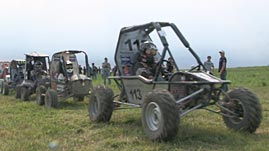Teachers' Domain - Digital Media for the Classroom and Professional Development
User: Preview

Source: Pennsylvania College of Technology/WVIA
In this video segment adapted from Pennsylvania College of Technology and WVIA, learn what it is like to take part in a collegiate automotive engineering competition. A manufacturing and technology student shares his experiences in the competition, in which teams design and construct rugged off-road vehicles and then go through four days of inspections and racing. Observe how he uses technology such as computer programs and a CNC machine to help build his team's vehicle. In addition, learn about some of the core events of the competition and how the experience helps prepare students for the job market.
Design competitions such as Baja SAE—which is organized by SAE (Society of Automotive Engineers) International, a society dedicated to advancing the engineering of self-propelled vehicles—provide valuable experience for students of engineering. The competition simulates a real-world engineering project by asking college students to design and build an off-road vehicle. Working as a team, students must find ways to deal with the many challenges of bringing a new product to market. For example, they must research, design, plan, build, and test their product. They must also learn about finance, project management, and marketing. In addition, the competition requires students to communicate effectively and work collaboratively; the success of a team is based not on the skills of any one team member, but on how well the team works together as a whole.
Design competitions allow students to step out of the classroom and apply their academic knowledge to real world experiences. Students get to practice skills—such as designing and drafting, manufacturing, and troubleshooting—that are useful for a range of future jobs. In fact, having these experiences can be quite helpful when applying for a job. Many job announcements state that candidates should have one to three years of experience, effectively ruling out new graduates. However, prospective employers look favorably upon the practical experience acquired in design competitions.
Engineering competitions are not only for college students—there are similar opportunities for high school students with interests in engineering, technology, math, and science. The FIRST Robotics Competition challenges teams to build robots to compete against each other in a specific game. The teams are given a standard parts kit, a set of rules, and six weeks to design and build their robots. Another competition for high school students, the National Engineering Design Challenge (NEDC), asks teams to design and build a working solution for a social need. For example, to create an assistive technology device for a person with a disability, students must use their creativity as well as their math, science, research, design, writing, and presentation skills. Engineering competitions such as these provide an engaging opportunity to learn about teamwork and gain real-world engineering and problem-solving experience.
 Loading Standards
Loading Standards Teachers' Domain is proud to be a Pathways portal to the National Science Digital Library.
Teachers' Domain is proud to be a Pathways portal to the National Science Digital Library.
